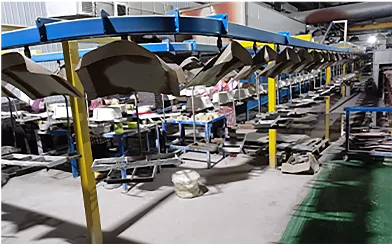
Restoring Your Cast Iron Frying Pan for Enhanced Performance and Longevity
Reconditioning Cast Iron Frying Pans A Step-by-Step Guide
Cast iron frying pans are known for their durability, excellent heat retention, and superior cooking capabilities. Over time, however, they can lose their non-stick properties and develop rust, making reconditioning essential. Here’s a step-by-step guide on how to breathe new life into your cast iron frying pan.
Understanding Cast Iron Reconditioning
Reconditioning is the process of restoring the frying pan's surface and reviving its non-stick properties. This typically involves cleaning, seasoning, and maintaining the pan properly. The beauty of cast iron pans is that they can last for generations if taken care of correctly.
Step 1 Gather the Necessary Supplies
Before you start, you'll need a few supplies - Steel wool or a metal scrubber (for rust and stuck-on food) - Mild dish soap (for cleaning) - Drying cloth or paper towels - Vegetable oil or flaxseed oil (for seasoning) - Aluminum foil (to catch drips in the oven)
Step 2 Remove Rust and Build-Up
1. Cleaning the Pan Begin by scrubbing your frying pan with steel wool or a metal scrubber. If there is any rust, this will help to remove it. For tougher residues, you can soak the pan in warm, soapy water for about 30 minutes before scrubbing.
2. Rinse and Dry After scrubbing, rinse the pan thoroughly to remove any soap. It’s crucial to dry the pan completely using a cloth or by placing it on low heat on the stove. Leaving any moisture can lead to rust formation.
Step 3 Seasoning the Pan
Seasoning is the key to restoring the non-stick surface and preventing future rust
.1. Preheat the Oven Preheat your oven to 450°F (232°C).
reconditioning cast iron frying pan

2. Apply Oil Once the pan is completely dry, apply a thin layer of vegetable oil or flaxseed oil on the inside and outside surfaces. Use a paper towel to spread the oil evenly, ensuring that there are no thick spots. This layer should be light; too much oil can lead to a sticky finish.
3. Bake the Pan Place the frying pan upside down in the preheated oven. Place aluminum foil on the lower rack to catch any drips, which helps maintain a clean oven. Bake the pan for one hour.
4. Cool Down After an hour, turn off the oven and let the pan cool inside. This gradual cooling process helps the seasoning bond with the cast iron.
Step 4 Maintenance Tips
Now that your cast iron frying pan is reconditioned, here are some maintenance tips to keep it in great shape
1. Avoid Soaking Do not soak your cast iron in water, as prolonged exposure can cause rust.
2. Use Minimal Soap While it's okay to use soap occasionally, it’s best to avoid it during regular cleaning. Instead, wipe the pan with a cloth or use hot water and a brush to remove food residues.
3. Dry Immediately After washing, dry the pan right away to prevent any moisture from causing rust.
4. Re-season as Needed Depending on how often you use your pan, you may need to re-season it every few months. Look for signs of dullness, stickiness, or rust as indicators for re-seasoning.
5. Store Properly Store your cast iron frying pan in a dry place. You can place a paper towel between the pan and its lid or other cookware to absorb any moisture and prevent scratching.
Conclusion
Reconditioning a cast iron frying pan is a straightforward process that ensures your cooking companion remains functional and enjoyable for years to come. With proper care and regular maintenance, your cast iron pan can not only enhance your cooking experience but also become a family heirloom, passed down through generations. So, roll up your sleeves, give your pan the TLC it deserves, and savor the delicious meals you'll create!
-
High Quality Kitchen Durable Black Round Cast Iron Cookware Pancake Crepe Pan With Wooden Handle-Baixiang County Zhongda Machinery Manufacturing Co., Ltd.|Non-Stick, Heat Retention, DurableNewsAug.08,2025
-
High Quality Cast Iron Cookware - Baixiang County Zhongda Machinery | Nonstick, Heat RetentionNewsAug.08,2025
-
Cast Iron Cookware- Baixiang County Zhongda Machinery|Non-Stick, Heat RetentionNewsAug.08,2025
-
High Quality Kitchen Durable Black Round Cast Iron Cookware-Pancake Crepe Pan With Wooden Handle|Nonstick Surface&High-Temperature ResistanceNewsAug.08,2025
-
Durable Enamel Coated Pans: Easy Clean & Versatile CookwareNewsAug.08,2025
-
High Quality Kitchen Durable Black Round Cast Iron Cookware Pancake Crepe Pan With Wooden Handle-Baixiang County Zhongda Machinery Manufacturing Co. , Ltd.NewsAug.08,2025


